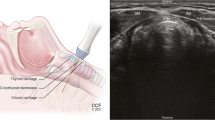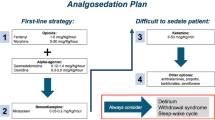Abstract
Venipuncture is a painful and invasive procedure for hospitalised newborns and represents a challenge for neonatal healthcare professionals. This study evaluated the most efficient cannulation method based on the proportion of success at the first attempt, standard care or near-infrared (NIR) device use, and pain assessment. An observational study with two arms was conducted in the neonatal intensive care unit (NICU) of a tertiary-care university hospital in Italy. All newborns undergoing peripheral vein cannulation and only nurses with more than 5 years of professional experience in the NICU were eligible for the first arm. Only newborns with a body weight of >2500 g at cannulation and all nurses working in the NICU were involved in the second arm. In the first arm of the study, no statistically significant differences between the NIR and control groups were found in terms of proportion of successful at the first attempt 60.6% (confidence interval [CI] 95%: 48.8; 72.4) vs. 56.1% (CI 95%: 44.1; 68.0) and the mean premature infant pain profile score 6.3 (CI 95%: 5.4–7.1) vs. 5.8 (CI 95%: 5.0–6.6). In the second arm, only among less experienced nurses (<1 year), we observed a significant increase in the proportion of success in the NIR group compared with the control group, nearly tripling the success rate (72.7% [54.1; 91.3] vs. 23.1% [0.2; 46.0]).
Conclusion: This study reported no differences between the NIR and control groups. The results also suggest that using a NIR device may be advantageous for healthcare professionals with less experience during first-time cannulation.
What is Known: |
• Venipuncture is a painful procedure commonly used to place a peripheral venous catheter for administering nutrients or drugs. |
• Near-infrared light facilitates the visualisation of veins and consequently, the performance of cannulation in the paediatric population. |
What is New: |
• The near-infrared light device was not associated with fewer attempts and a lower premature infant pain profile score in placing venous access in newborns than the traditional method. |
• The near-infrared light device could help nurses with less professional experience place a peripheral venous catheter. |
Similar content being viewed by others
Availability of data and material
Not applicable.
Code availability
Not applicable.
Abbreviations
- DIVA:
-
Difficult intravenous access
- NIR:
-
Near-infrared light
- NICU:
-
Neonatal intensive care unit
- PIPP:
-
Premature infant pain profile
References
Carbajal R, Rousset A, Danan C, Coquery S, Nolent P, Ducrocq S, Saizou C, Lapillonne A, Granier M, Durand P et al (2008) Epidemiology and treatment of painful procedures in neonates in intensive care units. JAMA 300(1):60–70. https://doi.org/10.1001/jama.300.1.60
Legemaat M, Carr PJ, van Rens RM, van Dijk M, Poslawsky IE, van den Hoogen A (2016) Peripheral intravenous cannulation: complication rates in the neonatal population: a multicenter observational study. J Vasc Access 17(4):360–5. https://doi.org/10.5301/jva.5000558
Larsen P, Eldridge D, Brinkley J, Newton D, Goff D, Hartzog T, Saad ND, Perkin R (2010) Pediatric peripheral intravenous access: does nursing experience and competence really make a difference? J Infus Nurs 33(4):226–35. https://doi.org/10.1097/NAN.0b013e3181e3a0a8
Kuensting LL, DeBoer S, Holleran R, Shultz BL, Steinmann RA, Venella J (2009) Difficult venous access in children: taking control. J Emerg Nurs 35(5):419–24. https://doi.org/10.1016/j.jen.2009.01.014
Hess HA (2010) A biomedical device to improve pediatric vascular access success. Pediatr Nurs 36(5):259–63
GomesPPde S, LopesAPde A, dos Santos MSN, FaçanhaSMde A, Silva AVSe, Chaves EMC (2019) Non-pharmacological measures for pain relief in venipuncture in newborns: description of behavioral and physiological responses. Braz J Pain 2(2):142–6. https://doi.org/10.5935/2595-0118.20190026
Alemdar DK, Tüfekci FG (2020) Effects of smelling amniotic fluid on preterm infant’s pain and stress during peripheral cannulation: a randomized controlled trial. Jpn J Nurs Sci 17(3):e12317. https://doi.org/10.1111/jjns.12317
Provenzi L, Fumagalli M, Sirgiovanni I, Giorda R, Pozzoli U, Morandi F, Beri S, Menozzi G, Mosca F, Borgatti R et al (2015) Pain-related stress during the neonatal intensive care unit stay and SLC6A4 methylation in very preterm infants. Front Behav Neurosci 9:99. https://doi.org/10.3389/fnbeh.2015.00099
Shahid S, Florez ID, Mbuagbaw L (2019) Efficacy and safety of EMLA cream for pain control due to venipuncture in infants: a meta-analysis. Pediatrics 143(1):e20181173. https://doi.org/10.1542/peds.2018-1173
Montirosso R, Casini E, Del Prete A, Zanini R, Bellù R, Borgatti R, NEO-ACQUA Study Group (2016) Neonatal developmental care in infant pain management and internalizing behaviours at 18 months in prematurely born children. Eur J Pain 20(6):1010–21. https://doi.org/10.1002/ejp.826
Shah VS, Ohlsson A (2011) Venepuncture versus heel lance for blood sampling in term neonates, editor. Cochrane Database Syst Rev 10:CD001452. https://doi.org/10.1002/14651858.CD001452.pub4
Lago P, Boccuzzo G, Garetti E, Pirelli A, Pieragostini L, Merazzi D, Ancora G (2013) Pain management during invasive procedures at Italian NICUs: has anything changed in the last 5 years? J Matern Fetal Neonatal Med 26(3):303–5. https://doi.org/10.3109/14767058.2012.725973
Çağlar S, Büyükyılmaz F, Bakoğlu İ, İnal S, Salihoğlu Ö (2019) Efficacy of vein visualization devices for peripheral intravenous catheter placement in preterm infants: a randomized clinical trial. J Perinat Neonatal Nurs 33(1):61–7. https://doi.org/10.1097/JPN.0000000000000385
Curtis SJ, Craig WR, Logue E, Vandermeer B, Hanson A, Klassen T (2015) Ultrasound or near-infrared vascular imaging to guide peripheral intravenous catheterization in children: a pragmatic randomized controlled trial. CMAJ 187(8):563–70. https://doi.org/10.1503/cmaj.141012
Heinrichs J, Fritze Z, Klassen T, Curtis S (2013) A systematic review and meta-analysis of new interventions for peripheral intravenous cannulation of children. Pediatr Emerg Care 29(7):858–66. https://doi.org/10.1097/PEC.0b013e3182999bcd
Madrid García A, R. Horche P, (2018) Light source optimizing in a biphotonic vein finder device: experimental and theoretical analysis. Results Phys 11:975–83. https://doi.org/10.1016/j.rinp.2018.10.033
Conversano E, Cozzi G, Pavan M, Minute M, Gortan E, Montico M, Vecchi Brumatti L, Ronfani L, Barbi E (2018) Impact of near infrared light in pediatric blood drawing centre on rate of first attempt success and time of procedure. Ital J Pediatr 44(1):60. https://doi.org/10.1186/s13052-018-0501-1
Chapman LL, Sullivan B, Pacheco AL, Draleau CP, Becker BM (2011) VeinViewer-assisted intravenous catheter placement in a pediatric emergency department. Acad Emerg Med 18(9):966–71. https://doi.org/10.1111/j.1553-2712.2011.01155.x
de Graaff JC, Cuper NJ, Mungra RAA, Vlaardingerbroek K, Numan SC, Kalkman CJ (2013) Near-infrared light to aid peripheral intravenous cannulation in children: a cluster randomised clinical trial of three devices. Anaesthesia 68(8):835–45. https://doi.org/10.1111/anae.12294
Park JM, Kim MJ, Yim HW, Lee WC, Jeong H, Kim NJ (2016) Utility of near-infrared light devices for pediatric peripheral intravenous cannulation: a systematic review and meta-analysis. Eur J Pediatr 175(12):1975–88. https://doi.org/10.1007/s00431-016-2796-5
Perry AM, Caviness AC, Hsu DC (2011) Efficacy of a near-infrared light device in pediatric intravenous cannulation: a randomized controlled trial. Pediatr Emerg Care 27(1):5–10. https://doi.org/10.1097/PEC.0b013e3182037caf
Rothbart A, Yu P, Müller-Lobeck L, Spies CD, Wernecke KD, Nachtigall I (2015) Peripheral intravenous cannulation with support of infrared laser vein viewing system in a pre-operation setting in pediatric patients. BMC Res Notes 8(1):463. https://doi.org/10.1186/s13104-015-1431-2
Strehle EM (2010) Making the invisible visible: near-infrared spectroscopy and phlebotomy in children. Telemed J E Health 16(8):889–93. https://doi.org/10.1089/tmj.2010.0061
Sun CY, Lee KC, Lin IH, Wu CL, Huang HP, Lin YY, Hsu YF, Yu HR (2013) Near-infrared light device can improve intravenous cannulation in critically ill children. Pediatr Neonatol 54(3):194–7. https://doi.org/10.1016/j.pedneo.2012.12.012
Stevens B, Yamada J, Ohlsson A, Haliburton S, Shorkey A (2016) Sucrose for analgesia in newborn infants undergoing painful procedures. Cochrane Database Syst Rev 7(7):CD001069. https://doi.org/10.1002/14651858.CD001069.pub5
Sorrentino G, Fumagalli M, Milani S, Cortinovis I, Zorz A, Cavallaro G, Mosca F, Plevani L (2017) The impact of automatic devices for capillary blood collection on efficiency and pain response in newborns: a randomized controlled trial. Int J Nurs Stud 72:24–9. https://doi.org/10.1016/j.ijnurstu.2017.04.001
Stevens B, Johnston C, Petryshen P, Taddio A (1996) Premature infant pain profile: development and initial validation. Clin J Pain 12(1):13–22. https://doi.org/10.1097/00002508-199603000-00004
Monasor-Ortolá D, Cortés-Castell E, Martínez-Pascual C, Esteve-Ríos A, Rizo-Baeza MM (2019) Factors influencing the success of peripheral venous access in neonates. J Pediatr Nurs 47:e30-5. https://doi.org/10.1016/j.pedn.2019.04.017
van Rens RMFPT, Reiss IKM, Latour JM (2012) Peripheral central catheter insertion: eyes or device? Pediatr Crit Care Med 13(5):607–8. https://doi.org/10.1097/PCC.0b013e31824fbdc9
Phipps K, Modic A, O’Riordan MA, Walsh M (2012) A randomized trial of the Vein Viewer versus standard technique for placement of peripherally inserted central catheters (PICCs) in neonates. J Perinatol 32(7):498–501. https://doi.org/10.1038/jp.2011.129
Messmer PR, Jones SG, Taylor BA (2004) Enhancing knowledge and self-confidence of novice nurses: the “Shadow-A-Nurse” ICU program. Nurs Educ Perspect 25(3):131–6
Walker SM (2019) Long-term effects of neonatal pain. Semin Fetal Neonatal Med 24(4):101005. https://doi.org/10.1016/j.siny.2019.04.005
Acknowledgements
The authors would like to thank all the nurses of the NICU of the Fondazione IRCCS Ca’ Granda Ospedale Maggiore Policlinico, Milan, Italy.
Author information
Authors and Affiliations
Contributions
SM, GC, and LP contributed to the study’s conception and design; SM, ST, SF, AA, GS, and EL acquired data; SF and GS wrote the first draft of the manuscript; IC calculated the sample size and performed the statistical analysis; GC, LP, and FM provided extensive critical revision. All authors contributed to the critical revision of the manuscript and have read and approved the submitted version.
Corresponding author
Ethics declarations
Ethics approval
This study was approved by the local Ethics Committee (Milan Area 2, Italy) with reference number 920/2012.
Consent to participate
The parents of the newborns provided written informed consent for participating.
Consent for publication
The parents of the newborns provided written informed consent for publishing the results.
Competing interests
The authors declare no competing interests.
Additional information
Communicated by Daniele De Luca
Publisher's Note
Springer Nature remains neutral with regard to jurisdictional claims in published maps and institutional affiliations.
Rights and permissions
About this article
Cite this article
Ferrario, S., Sorrentino, G., Cavallaro, G. et al. Near-infrared system’s efficiency for peripheral intravenous cannulation in a level III neonatal intensive care unit: a cross-sectional study. Eur J Pediatr 181, 2747–2755 (2022). https://doi.org/10.1007/s00431-022-04480-1
Received:
Revised:
Accepted:
Published:
Issue Date:
DOI: https://doi.org/10.1007/s00431-022-04480-1




